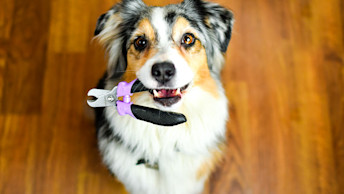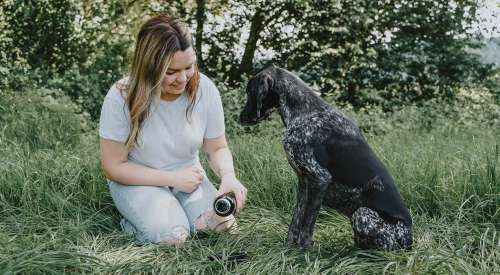September 27, 2021
How to Trim Your Dog’s Nails Safely at Home

Do you get anxious when you have to cut your dog's nails? Don't worry; it's common amongst dog parents.
However, nail trimming is a vital component of caring for your dog. A dog's nails are a sign of good health and hygiene. Fortunately, instead of always visiting the dog groomer, you can do the task yourself at home.
The process to trim cut dog nails is simple when you know how to do it correctly. Keep reading to learn the proper way to cut dog nails, so you can feel confident in providing the best care for your dog!
The Importance of Cutting Dog Nails
If you don't cut your dog's nails, you could be causing them pain. Dog nails have two parts. The first is the living pink quick. The second is the hard outer shell.
The quick supplies blood to the nail. It runs through the core of the nail. When you don't trim the nails often, the quick grows longer with the nail. This makes bleeding more probable when you do cut the nails.
In addition, long nails can cause the foot to splay, deform the paw, injure tendons, and reduce paw traction. This is because long nails put extra pressure on the feet and legs.
Cutting your dog's nails is essential to keeping your dog healthy and thriving.
How to Trim Dog Nails
There is no one method to trim dog nails. However, no matter which tool you choose, you want your dog to feel comfortable and relaxed. One bad experience can cause a dog to have fear about nail trimming in the future.
The Tools
You can choose between using
- Small nail scissors
- Large nail clippers
- A grinding tool
Grinding tools come with different heads for trimming and grinding the nail versus smoothing and buffing the nail.
Many large nail clippers are guillotine-style, so the nail stays in place as your cut. This is great for anxious dogs who may try to move around as you cut.
Small nail scissors are only suitable for small dogs because dog nails are thick compared to human nails.
Always consider the size of your dog before you decide which tool to use.
You also want to have treats and styptic powder on hand. Styptic powder helps if there is bleeding.
If you don't have styptic powder, you want a thick powder that will absorb blood and help with clotting. Good examples are cornstarch and flour.
How to Begin
If your dog is incredibly anxious, follow these steps:
- Show the scissors, nail clipper, or grinder
- Touch the tool to their paw
- Praise your dog and give them a treat
Use their favorite kibble instead if you don't have treats or your dog isn't treat-motivated.
You can continue showing the tool and touching their paws by giving praise and treats to help them relax. Don't start by clipping off an entire section of the nail. Instead, you can clip the tip of one nail while giving praise and treats.
You may not be able to clip all of your dog's nails at one time. In the beginning, you may only be able to cut one nail. Therefore, this process may take a few days until the dog starts to feel more comfortable.
If your dog continues to feel stressed about getting its nails clipped, ask someone to help you. Especially for larger dogs, it helps when one person can give praise and treats while the other does the cutting.
The second person can also help keep the dog still to further avoid bleeding as you clip.
The Next Steps
Once your dog is more comfortable around the tool you are using, you can get in a good position to clip the rest of the nails. Some dogs like to be in your lap, while others like to lay on their side on the floor.
When you and your dog are ready, you can continue with these steps:
- Use your thumb to push the pad of a toe gently
- Keep your forefinger on the top of the toe as you push
- Once the nail extends, clip it
As mentioned before, if you clip too far, you will nick the quick and cause bleeding. Therefore, you want to leave about two millimeters of space between the quick and the end of the nail.
It is easy to see where the quick is on dogs that have light-colored nails. Unfortunately, for dogs with brown or black nails, you won't be able to know where the quick ends.
However, if you don't clip past the curve of the nail, you usually can avoid nicking the quick. For dogs with dark nails, start by trimming a small section first. Look for a chalky white ring to signal you are getting close to the quick as you proceed.
Don't Forget the Dewclaw
The dewclaw is like a dog's thumb. It doesn't wear down as much as the other nails do during normal activity for most dogs. Therefore, it is important to trim the dewclaw like the rest of the nails.
It may need trimming more often than the other nails for dogs that aren't as active.
What Happens If Nails Bleed?
No one is perfect, so if any nails start to bleed, don't panic! Accidents happen. Dip the bleeding dog nails into the styptic powder, flour, or cornstarch to stop the bleeding.
The powder will also help to stop bacteria from getting into the dog's bloodstream. To avoid bleeding in the future, trim dog nails regularly so the quick recedes as the nails shorten.
Feel Confident in Trimming Dog Nails
Using this guide, you should feel confident to trim cut dog nails on your own. However, make sure to stay calm and relaxed when trimming the nails so that your dog also remains relaxed and comfortable.
With practice, trimming your dog's nails will feel easy! But remember, cutting your dog's nails is just one step in the process of keeping your dog healthy.
If you have more questions about how to care for your dog, make sure to check out our all about dogs section for more tips!



